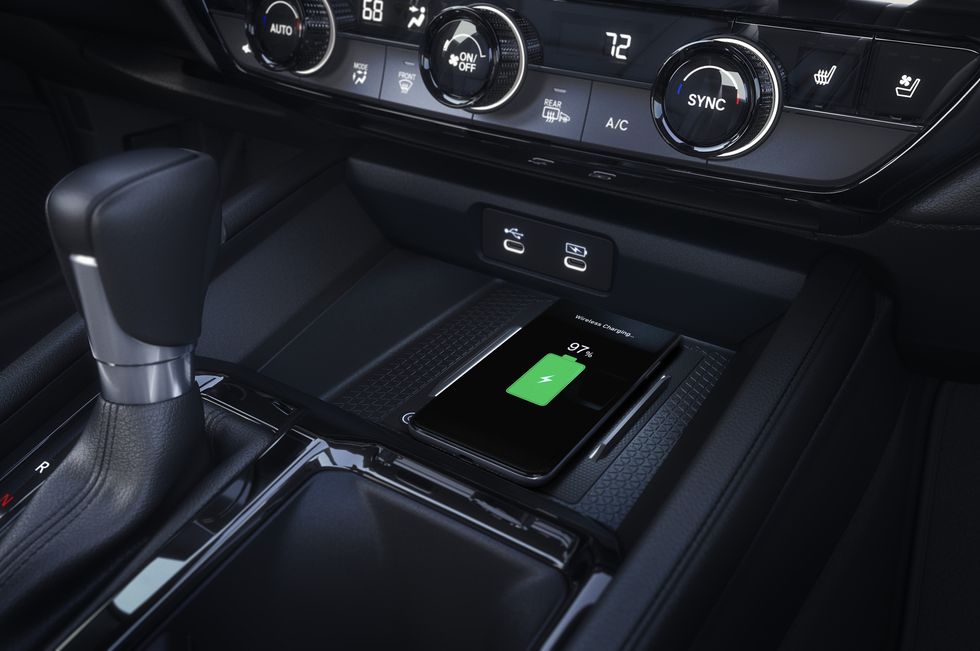2023 Honda Accord Hones Its Edge

It’s easy to love the Honda Accord, a consistently solid and likable family sedan that deftly manages the trick of combining frugality, functionality, dependability, comfort, and driving enjoyment in one affordable package. The new 11th-generation 2023 Honda Accord absolutely lives up to those longstanding high expectations, and an earlier drive led our editorial staff to name it to our 10Best list for, get this, the 37th time.
Greater Length
Drawn out 2.7 inches longer than before, the Accord’s sleek and fresh styling hides the fact that it shares many of its other dimensions with the outgoing model. Both ride on a 111.4-inch wheelbase, stand 57.1 inches tall, and span 73.3 inches wide. Trunk volume is unchanged at an impressive 17 cubic feet. But it’s not all samesies. Subtle yet consequential rear suspension tweaks have expanded the rear track width by 0.4 inch, and that translates into a matching increase in rear hip room. What’s more, the old model’s limo-like rear legroom of 40.4 inches has grown to 40.8 inches, making the Accord’s child-seat- and adult-friendly back seat a touch more spacious. Of course we will miss the turbocharged 2.0-liter four-cylinder engine that didn’t make the cut this time around—it made the previous-gen Accord a rocket—and the manual transmission, dropped in 2019, isn’t coming back either.
Turbo Base Engine
The LX and EX kick things off at the low end of the trim spectrum, and they’re expected to represent half of Accord sales. They come with cloth seats, a 7.o-inch touchscreen, and 17-inch wheels and tires. They are also the lone offerings with the turbocharged 1.5-liter four-cylinder engine. It makes the same 192 horsepower and 192 pound-feet of torque as before, but it’s not a direct carryover. Strategic revisions, including a new catalyst that utilizes less rare-metal content, have been applied to help the 1.5T meet ever-tightening emissions regulations.
In the bargain, peak rpm for horsepower and torque waft slightly upward. EPA estimated fuel economy, on the other hand, slumps by 1 mpg to 32 mpg combined (29 city/37 highway) owing to some 90 pounds of added weight. Still, that’s a decent showing for what is an increasingly large sedan. This lightly massaged turbo engine is less gruff than in the CR-V, and its CVT transmission has been retuned to better simulate upshifts and reduce belt noise. It’s a generally pleasing combination around town, but any amount of growl or residual CVT drone stands in contrast to the more refined hybrid powertrain.
Enhanced Hybrid
A new fourth-generation hybrid powertrain will motivate the upper portion of the lineup. It’s much the same as the hybrid system we first fell for in the 2023 Honda CR-V, with a 2.0-liter Atkinson-cycle four-cylinder engine (making 146 horsepower and 134 pound-feet in Accord guise) paired with two electric motors. One motor contributes 181 horsepower and 247 pound-feet to propulsion while the other is a generator driven by the engine. Total combined output is 204 horsepower and 247 pound-feet, which is 2 horses and 15 pound-feet more than before. The EX-L, which rides on 17-inch tires, is rated at 48 mpg combined (51 city/44 highway), while the Sport, Sport-L, and Touring earn 44 mpg combined (46 city/41 highway) on 19-inch rolling stock.
Three invisible drive modes work behind the scenes. From rest, a small 1.1-kWh battery enables electric drive until about 20 mph by deploying previously harvested braking energy. As speed increases, series-hybrid mode pairs the engine and generator to feed the electric motor in real time, giving the Accord the smooth, effortless torque (but not the sound) of an EV. At cruising speed, the engine is seamlessly clutched in to directly power the wheels, with vehicle speed and engine rpm in lockstep. The Accord only does this at moderate highway speeds—the CR-V hybrid’s additional low-speed lockup has been omitted because the sedan is lighter, sleeker, and not rigged for towing.
Honda
Accelerate hard (or climb a hill) and the system reverts to electric-motor propulsion, with the engine once again powering the generator instead of the wheels. Engine revs during such spirited acceleration sweep through a series of simulated upshifts, even though forward drive remains a steady pull from the electric motor. The apparent shifting is an intentional bit of misdirection that adds normalcy and avoids unnatural engine droning on the way to what we reckon is a 7.1-second run to 60 mph.
Like all hybrids, the Accord uses its main drive motor to convert deceleration energy into battery electricity. There are six (!) driver-selectable regeneration levels that range from normal to nearly one-pedal driving. Oddly, although we prefer high regen in EVs, here, applying the brakes the usual way seems more natural. It’s a satisfying way to go too, because Honda’s engineers did a masterful job of blending the regenerative and friction braking systems to deliver consistent brake feel. It’s not an unsatisfying pedal you’d be happy to avoid.
Refined Chassis
Ride and handling are smoother and better regulated than ever. This is especially true of the models with 19-inch wheels, as each engine/wheel-size combo gets its own damper tune to offset such inherent differences. Credit also goes to the enlarged and realigned rear trailing-arm bushing, which reduces impact harshness without adding lateral squishiness that might screw up the Accord’s cornering prowess. In fact, the steering feels even more clear thanks to low-friction ball joints and a revised upper-strut mount. But there is a caveat. Hybrids have Normal and Sport settings that alter throttle sensitivity and steering effort, among other things. Steering feels far more authentic in Normal, whereas in Sport it seems artificially heavy (there are also Econ and mix-and-match Individual settings).
Hybrids also get another desirable standard upgrade in the form of a 12.3-inch touchscreen that supports wireless phone mirroring (the 7.0-inch system needs a cable). It’s a thoughtful implementation, with a broad finger rest that makes selections easy and a welcome volume knob (that could be larger). Honda expects people to mirror their phones and use familiar apps, so factory navigation and satellite radio are absent. The Touring adds Google Built-In, which offers Google Assistant and a full integration of Google Maps. You can also “Hey, Google” your way to climate control and other in-car adjustments that a paired smartphone can’t match, but we’re not sure it’s a must-have. It is complimentary for three years, but the re-up price is TBD.

Honda
Zooming out, the overall interior look and feel is eye-catching and features the same sort of attractive cross-cabin matrix trim that conceals the adjustment fins of the good-size air vents, just as it does in the Civic and CR-V. The climate-control interface itself is likewise clear and logical, and many of the other controls are so obvious and straightforward that the manual may never get unwrapped. As for the seats, beyond kudos for their ability to hold fast in corners, our notebook is largely devoid of comments because they absolutely do the job without making any kind of unwanted, shall we say, impression after a day in the saddle.
Pricing ranges from $28,390 for an LX with the turbo engine, cloth seats, and no sunroof up to $38,985 for the decked-out Touring. In between, our favorite is the $34,635 EX-L, which is the fuel-economy champ owing to its 17-inch rubber. But the Sport-L is priced nearly the same at $34,970, and it trades a few mpg, heated side mirrors, rear air vents, and rear USB-C charge ports for 19-inch matte black wheels and Sport appearance bits. And that’s just it: There are no wrong answers with this latest Accord, and it’s been that way for decades.
Specifications
Specifications
2023 Honda Accord
Vehicle Type: front-engine or front-engine, front-motor; front-wheel-drive; 5-passenger; 4-door sedan
PRICE
LX (1.5T), $28,390; EX (1.5T), $30,705; Sport (hybrid), $32,990; EX-L (hybrid), $34,635; Sport-L (hybrid), $34,970, Touring (hybrid), $38,985
POWERTRAINS
turbocharged and intercooled DOHC 16-valve 1.5-liter inline-4, 192 hp, 192 lb-ft; DOHC 16-valve 2.0-liter Atkinson-cycle inline-4, 146 hp, 134 lb-ft + AC motor, 181 hp, 247 lb-ft (combined output: 204 hp, 247 lb-ft; 1.1-kWh lithium-ion battery pack)
Transmissions: continuously variable automatic; direct-drive
DIMENSIONS
Wheelbase: 111.4 in
Length: 195.7 in
Width: 73.3 in
Height: 57.1 in
Passenger Volume, F/R: 53–56/50 ft3
Trunk Volume: 17 ft3
Curb Weight (C/D est): 3250–3550 lb
PERFORMANCE (C/D EST)
60 mph: 7.1 sec
1/4-Mile: 15.5–15.7 sec
Top Speed: 116 mph
EPA FUEL ECONOMY
Combined/City/Highway: 32–48/29–51/37–44 mpg



